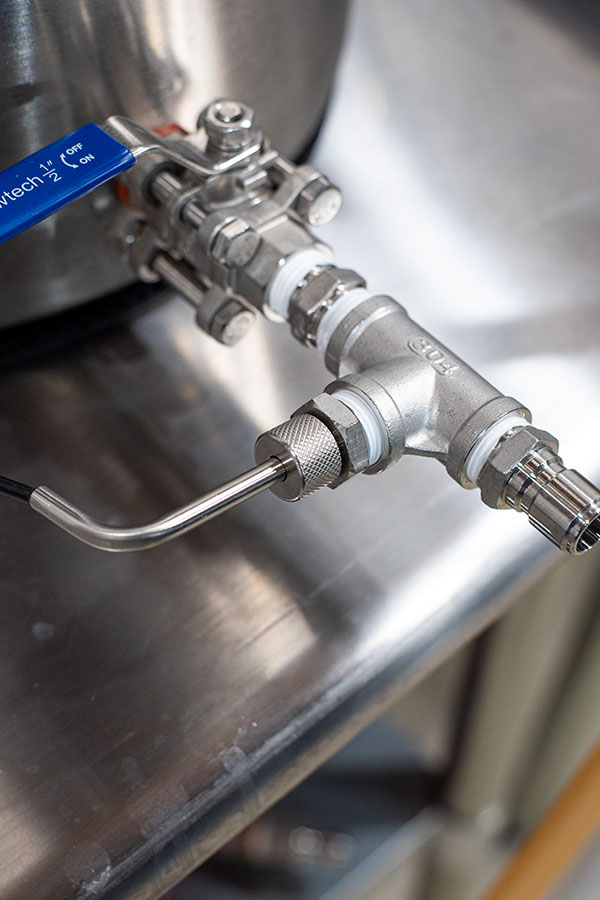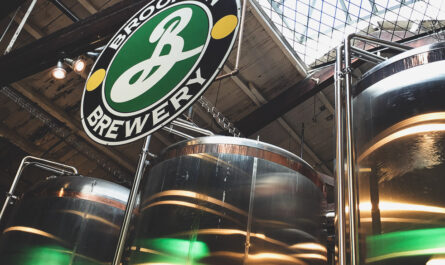My electric brewery is built using a kettle RIMS (K-RIMS) setup—essentially a 2 vessel system that is a horizontal version of the Blichmann BrewEasy™. A kettle RIMS system eliminates the hot liquor tank of a traditional three-tier system along with the sparging process. K-RIMS is basically a 2-vessel brew in a bag (BIAB) system, but with a few advantages. The system has certainly drawn some skepticism from homebrewers because it ultimately achieves a very similar result to BIAB but with extra equipment and cleaning.
Overall, I wanted a simple system that would shorten brew day but give me the option to upgrade to a 3V system if I wanted. K-RIMS can be built in both electric or gas. I previously used it as a propane system before ultimately converting to electric and moved my brewing to the basement.

What is RIMS?
RIMS stands for recirculating infusion mash system. During the mash, the wort is pumped from the MLT through a heated RIMS tube that directly heats the wort as it passes through the channel. The wort is returned to the top of the mash where it continuously cycles. A K-RIMS builds off the same login but uses the boil kettle element as the RIMS heat source to maintain the mash temp.
My System

My electric Kettle RIMS system features 2 Ss Brewtech kettles—a dedicated 10-gallon mash lauter tun (MLT) and a 10-gallon boil kettle with a 5500-watt stainless ripple element. My heating element is installed via a 1.5 inch TC port and is powered by the Blichmann BrewCommander™. A kettle RIMS system features a full volume mash with constant recirculation for grain filtering, wort clarity, and uniform heat throughout the mash tun. 2 pumps (Riptide and a March with a Riptide conversion kit) continuously recirculate the mash from the mash tun to the boil kettle to heat and maintain mash temps.
My BrewCommander’s thermometer lives in a T valve on my boil kettle exit, which ultimately manages the mash temps as it returns to the top of the mash tun. The BrewCommander has a RIMS temp offset feature that allows you to account for temperature loss between the mash tun and boil kettle.
Due to a dedicated mashing vessel, a grain bag is not required to be hoisted and drained. That being said, I have seen some K-RIMS systems use a grain bag in the mash tun. The rationale is you can use a finer grain crush (to boost efficiency), eliminate any risk of grains leaving the mash, and make grain disposal and cleanup a lot easier.
AutoSparge
The Blichmann AutoSparge is an essential part of the K-RIMS mashing process. It makes regulating the flow between the two kettles/pumps an automated process. Without it, you will have to monitor mash and boil kettle wort volumes manually. It’s not quite as simple as exactly matching flows between the two pumps because variances can occur depending on how the mash tun drains.
The AutoSparge will automatically set the flow rate and liquid level into your mash tun. If the flow rate changes, the AutoSparge will respond by increasing or decreasing flow from the boil kettle to keep a constant level in the mash tun. What I do is ensure that pump 2 (mash tun in) is slightly outrunning pump 1 (boil kettle in) that way the AutoSparge can match the flow for me. If you do the reverse, you will end up draining your mash tun as the pump won’t be able to resupply wort fast enough.




How It Works: Brew Day Steps
- Brew day begins with half of the total water volume in each vessel. I add my water salts to the mash tun at this time and begin recirculation until I reach strike temp.
- Turn off all pumps, the heat, close all valves, and dough in. Let the grains rest for 10 minutes, take a PH reading, adjust if needed.
- Turn on pump 1 and start recirculating the mash tun into itself. This will initially filter and let the grain bed settle. This ultimately replaces manual vorlauf (and works 1000 times better). Once the wort is free of any grain particles. I resume the full system recirculation. It may take a minute or two to bring mash back up to mashing temps if it’s dipped.
- Mash for 1 hour. I learned an important tip to periodically rake the top 1/3 of your mash bed throughout the mash. Doing this every 10-15 minutes will reduce channeling, clumping, and temp gradients in your mash. This will help to ensure you hit if not boost your efficiency a little.
- At the end of the mash, drain the mash tun of all remaining wort into the boil kettle. I start to heat my wort in the boil kettle as the mash is draining. This saves some time a little bit of time, not that I wait long away with the 5500-watt element.
- Proceed with boil and the rest of your brew day.
Benefits Over BIAB
No Grain Bag or Pulley Required
My skepticism with jumping to BIAB was the need of hoisting a heavy grain bag out of your mash tun/boil kettle when the mash is complete. Hoisting 20-30 pounds of water-saturated grains can be a messy and annoying task. Most brewers adopt some sort of pulley system that allows them to hoist the grain bag out and let it hang for several minutes to finishing draining. At some point I’m going to try BIAB just to compare. It would be a minimal investment at this point.
Clearer Wort
Since K-RIMS features continuous recirculation in a separate mashing vessel, it enables you to achieve very clear wort. I installed a flow site glass on my mash tun entrance so I could monitor wort clarity during my vourlof recirculation stage. Clearer wort leads to less trub in the boil kettle and fermenter. The pictures below were taken about halfway through the mash.


Kettle RIMS Efficiency
System efficiency is about the same as BIAB, around 68-72%. Like BIAB, it also offers a simple and faster brew day because it’s a full volume, no sparge mash. You COULD do a very basic manual sparge with cold water to try to boost overall efficiency. This would consist of pouring cold tap water over the mash tun as the wort drains to the boil kettle to effectively rinse the grains. Efficiency is not something I’m overly concerned with.
A common misconception of mash recirculation is that is increases efficiency. This is not really true. The main benefit is a means of maintaining an even mash temp throughout the entire mash tun, as well as clear wort from grain bed filtering.
Final Thoughts
Overall, I like my system and the overall process. It’s not for everyone and certainly comes with some tradeoffs. It’s not as straightforward as BIAB and requires more equipment and two pumps unless you tier the system and use gravity. It also requires more cleaning than BIAB. For some, this would be a deal-breaker. That being said, the biggest factor for me with choosing K-RIMS was all the BIAB benefits while avoiding cleaning and hoisting a grain bag from the ceiling in my basement.





I have the same type of system coming in the mail. Just used Blichmann Kettles and a BruControl Uniflex for the controller. Can you elaborate more on this
“I learned an important tip to periodically rake the top 1/3 of your mash bed throughout the mash. Doing this every 10-15 minutes will reduce channeling, clumping, and temp gradients in your mash. This will help to ensure you hit if not boost your efficiency a little.”
are you simply just using the mash paddle to disturb the top layer of the grain bed? basically forcing the water coming out of the autosparge tube to trickle through more evenly?
Thanks for the cool write up.
Exactly correct. Basically, churn up the top by evenly raking across. I learned this from BrewEasy users.
How are you calculating total water volume needed? Since it is a no sparge system I would assume you would treat the calculation the same as you would for BIAB? You make mention of splitting the total water volume between the two kettles equally. “half of the total water volume in each vessel. ” Is there an advantage in this methodology vs treating the mashtun volume more like a 3-vessel system and using something like 1.25qt per LB of grain in the recipe?
Hey Angelo – correct, I calculate similarly to BIAB. I would also look at BrewEasy instructions and usage guidelines since this is the same system except horizontal. I started with the water split but honestly, you want just enough in the mash tun to cover the grains. The other thing you need to consider is having enough water in the BK to cover the heating element if using electric like me. That is the only thing you really need to keep an eye on.
From all your IG posts looks like you converted to a SVBS (BIAB) only now? Why the change? I imagine the simplicity of it?
Correct – I tried it once for comparison’s sake and never looked back. Dealing with a grain bag can be a little annoying at times but I don’t miss cleaning out a mash tun. The only aspect I miss is clearer wort. I crush fine so picking up extra flour is inevitable.
That works!! I went from EBIAB to K-RIMS with the ultimate goal of eventually graduating to a HERMS system. I have had really good luck with the BrewEasy style system so far. Clean up does stink especially when you have 35+ lbs of grain in the mash tun. I could never get over the 70% efficiency from the single kettle system. Getting around 74-75 on the dual vessel which does not translate to much at a 10 gallon batch level. One thing you have going for you on the clarity side of the equation is you brew a lot of hazy beers!!!
Thanks for all the cool articles!! Your reads are quick and enjoyable.
Cheers!
What kind of false bottom were you using for this particular system?
Using the Ss domed false bottoms
I have a very similar setup only with two 20 gallon kettles. I am struggling with the calculation of water salts in regards to volume. Since it is a full volume mash the amount of salts required to achieve optimal mash pH will become concentrated from boil off and kettle loss. Example, 18-19 gallon total volume (mash+boil) for a 11-12 gallon batch (fermenter). I know I will lose equal parts salts/water in the mash from the grains but will still end up with an increased concentration of salts post boil. Is this something I should be worried about? Can I go about these calculations differently?
These are great questions and I’m probably not qualified to answer them. I go by what my brewing software tells me based on my profiles and I have not had any issues. I do not think you need to go about this differently. FWIW, I think you’re losing substantial salts in the mash that likely offset any increased concentrations from boiling.
Sorry to drudge up an old article. Hoping you’re still watching this page. But I had a question: would you just manually control one of the pumps since the brew commander can only do one? I’m building a similar system and wanted to use it, but not sure I want to manually work one pump. Thanks!
I manually controlled both pumps with a power strip with individual switches. This was the easiest for this build. After a few years of BIAB, I would probably say the kettle rims design is not worth the aggravation.